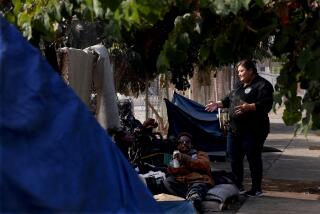SHE HELPS THE IMPOVERISHED TO FIGHT BACK
- Share via
The woman’s doctor told her to get herself to a hospital the moment the first sharp labor pain distressed her. Shyly, she nodded that she understood the instructions.
When it was time to deliver the baby a few days later, the woman found herself writhing in pain in a crowded, one-bedroom apartment with other small children crying and adding to her discomfort. No one was there who could drive her to the hospital.
By late afternoon, as the woman was about to deliver a baby boy in her own bed without assistance or medical attention, Anne Rivera, a social worker in the impoverished Buena Clinton neighborhood of Garden Grove, remembered that she hadn’t seen the very pregnant mother for several days.
Races to Woman’s Home
Rivera rushed out of her small office at La Amistad de San Jose Clinic on Clinton Street, running the two blocks to the woman’s home, finding her about to deliver. The social worker got help and rode with the woman to the hospital, arriving just in time to safely deliver the baby. Once the mother was in safe hands, Rivera returned to the apartment and found someone to take care of the woman’s other children until she returned.
That was last September, but little has changed for Rivera at the 2-year-old clinic.
“Just about everything around here is a crisis. It’s always something of urgency,” Rivera said as she looked out into the three-square-block neighborhood that has been categorized as one of Orange County’s worst slums.
Less than a year ago, it would have been inconceivable for anyone--let alone an enterprising Anglo woman -- to have barged into that apartment to help the young mother. Today, there is hardly an apartment door in Buena Clinton that is not open to the 37-year-old social worker.
Skeptical of Outsiders
Outsiders have not been much welcomed in the 39-acre slum that is home to more than 5,000 people, most of them very poor and more than 80% of them Latino.
Mostly undocumented workers, the Latinos and the few Asians who also live in the area have clung to their customs and remained wary of people who have tried to improve conditions in the neighborhood, according to area officials. Yet Rivera is not only welcomed but is regarded almost universally by the residents as their advocate.
City and county officials familiar with the clinic and Rivera’s work say she has managed, partly because of her gregarious nature and visible presence in Buena Clinton, to gain the residents’ trust in helping them solve problems involving food stamps, transportation or the replacement of a sink or window.
It is from a small office on the second floor of the free clinic, funded and operated by St. Joseph Hospital of Orange, that Rivera dispenses advice and acts as trouble-shooter for Buena Clinton residents.
She has helped many undocumented residents seeking amnesty to find competent lawyers and organizations to help them process their applications. She has even helped a family make funeral arrangements after the sudden, tragic death of a toddler.
“We try to take care of all problems and concerns -- from housing to personal matters,” Rivera said.
Married to a Colombian, Rivera is a gregarious woman who speaks fluent Spanish, an asset among doubting Buena Clinton residents who often have been suspicious of outsiders.
When she is not in the office listening to their problems or making telephone calls to help solve them, Rivera usually is roaming the neighborhood, chatting with residents and inspecting dilapidated apartments to see what defects landlords have failed to repair.
Rivera admits she is only “a friendly authority,” a private citizen working for a private corporation. In many cases, she can only refer residents to public agencies with more clout. Mostly, she said, “I do an awful lot of listening.”
Yet her command of Spanish and love for the Latino culture have helped her not only to understand the daily problems faced by Buena Clinton residents, but also their generations-old customs.
“I get a lot of satisfaction here because I feel I contribute in a meaningful way to my native culture and to my adopted culture,” Rivera explained. “I feel like I fit here.” Rivera, who was born and reared in Long Beach, did not come into her adopted culture simply by learning Spanish. Promptly after graduating from college, she went to Cartagena, an ancient coastal city in Colombia, where she taught English to Colombians and learned their native language and customs.
When her contract with the local language institute ended, Rivera decided to stay, moving to Leticia, a small city in southeast Colombia, in the heart of the Amazon jungle near the Peruvian and Brazilian borders. She stayed there for five years, serving as a tour guide.
Along the way, she married Olegario Rivera, an enterprising Colombian who worked for a bank in Leticia. In 1981, they returned to Southern California with her daughter, now 11. Rivera resumed teaching in Long Beach, then worked for the Boy Scouts and Girl Scouts before landing her present job 10 months ago.
As she gleefully reminisces about adventures in the Colombian jungle, where she was the only American woman, a steady stream of women stop by her door to greet “Anita,” as most in the neighborhood call her.
“Hola, como estas!” she fairly shouts to each of them.
One young woman named Maria approached Rivera to ask for advice about legalization under the new federal amnesty law. The woman, whom Rivera had never met, told her she didn’t have the proper documents to prove she had been in the United States long enough to qualify for citizenship.
“No te precupes (don’t worry),” Rivera tells her, then jots down the name and address of an institution in Santa Ana that can probably assist her.
“I can’t make her go. But if she does go, they will help her, and she’ll come back and tell everyone in her building,” Rivera said after Maria had rushed away.
Not all problems are as easy to handle, however. And sometimes, a temporary solution is the best that can be achieved.
Recently, Rivera recalled, a woman bleeding from a beating her husband had given her showed up in her office. Police were summoned and a report taken. But the officers refused to arrest the husband, Rivera said. Then, steeled by Rivera’s support and a vow not to return to her husband’s battering ways, the mother of three small children offered the police a deal.
“If I tell you where he keeps his drugs, will you arrest him?” the woman asked the officers.
“I was stunned, and so were the cops. They couldn’t believe this woman was saying this,” Rivera said.
The man, a suspected drug dealer, was arrested. The woman said her husband remains in jail, and, according to Rivera, neighbors have rallied to help her and her three children.
“It has changed the attitude a little bit. People support her for doing that. But she’s afraid her husband will come back and hurt her,” Rivera said. “I don’t really know if she did the right thing, but you have to admire her because she was real close to being out on the street.”
Garden Grove city officials contend that although Buena Clinton is still blighted, there has been improvement during the past two years. An industrial park has been built, some buildings torn down and, generally, the city has put pressure on wayward landlords to fix up apartments.
“Buena Clinton is continuing to progress and is not having the negative impact to the area it once did,” said Greg Devereaux, Garden Grove’s director of housing and neighborhood development.
Devereaux said Rivera has been “doing excellent work” in Buena Clinton and has been instrumental in advising residents of continuing plans to revitalize the neighborhood.
“She provides us with a very strong link to the community, and she has been a very big influence there,” he said.
Devereaux added that Rivera’s “ability to communicate with the residents, and her care and concern for them, has resulted in them getting services that they otherwise would not have gotten.
“Sometimes those people are afraid to approach people in authority directly, and she certainly helps them with that,” he said.
Tom Uram, director of the county’s Health Care Agency, who is familiar with all the services provided at La Amistad de San Jose, said he is impressed by the staff there, including Rivera, and said they all are aware of the special problems of the poor.
“A Special Need”
“They respond to a special need in that community,” Uram said.
Although Rivera said she has seen slow improvement in Buena Clinton, she acknowledges that “housing is still the most critical issue here.”
An hour after Rivera made that point, Maria Orosco walked into her office to seek help in filling out a document for her husband. Orosco, pregnant with her fifth child, has lived in the neighborhood for almost eight years.
Orosco complained that mice and roaches that had previously infested her apartment on Keel Street had returned.
“Well, we’ll have to make some calls on that right away,” Rivera said after admonishing Orosco for not complaining sooner.
In the 10 months Rivera has been at her job, she said, the residents have become more attuned to their needs and their basic rights as tenants. “I am seeing more and more a willingness to become aware of their rights and to act upon them,” she said.
Again, she illustrated her point with a story: “A woman, a legal resident, came in here not long ago. She was pretty angry. She told me about the problems with her apartment and how the landlord wasn’t fixing anything.
“And she knew she was right because the last thing she said was, ‘I may not be entitled to anything else, but I have a right to a bathroom.’ Boy, I was impressed with that.”
Rivera then began a walking tour of the neighborhood. At one apartment, a Salvadoran woman pointed at deep cracks in her bathroom. The walls, instead of being replastered, had been sloppily painted, and big blotches of the white paint had landed on the floor.
“My viejo (husband) was very angry. He almost got into a fight” with the painter, the woman said.
At another apartment, a woman pointed to a hole above her bathtub caused by the collapse of the plumbing in the unit above hers. “When it fell, a bunch of rats and big cockroaches fell out too,” she said.
Rivera said she would be back to take a full report and renew pestering the landlord to fix the bathroom and the hole in the ceiling.
Worries About Son
At another apartment, Maria Imelda Gutierrez lamented about the lingering drug problem in the neighborhood. Gutierrez, who has six children, was widowed two years ago when her husband was mugged and killed nearby. She worries about her 14-year-old son getting involved in drugs.
“Day and night, they are selling stuff around here,” Gutierrez said. “I don’t care how big my son gets or how many whiskers he grows, I’m going to stay after him.”
Back in her office, Rivera gazed out her window into the sunny street. Ice cream vendors -- who sometimes sell more than Popsicles--cruise slowly by. Kids are running home from school while a few young men congregate at street corners, idling life away with soft drinks.
To her, the poor people of Orange County’s best-known slum are special.
“They are nice people. They are very hard-working and they care very much about their children,” Rivera said. “But people in Buena Clinton are perceived as poor and shiftless . . . with drug problems.
“But when you get to know this neighborhood, you realize that is a very small percentage of the people.”
In her first nine months on the job, Rivera said she handled 509 visits by residents to her office. More important, she said, “I just try to be their friend” because the contact with her and the clinic is the only one that many residents of Buena Clinton have with the outside world.
“Unfortunately, not speaking the language, not being legal in most cases and being uneducated, they feel very isolated,” she said. “So we have to provide something deeper than just advice and help. It’s like the clinic is a window to the rest of the world for them.
“And as long as the clinic is here, I’ll stay. I belong here.”
BUENA CLINTON Population: 5,000-6,000 residents; 80% Latino and 10% Indochinese. Majority of residents are undocumented. 46% lived outside United States in 1979 or later. Size: 39-acre neighborhood in Garden Grove Housing: An average of seven people live in each apartment; some one or two-bedroom apartments house up to 12 people. Crime rate: 400% above the city average. 1,400 requests for police services each year. Medium income: $12,987 in 1984. 28% of households are below poverty level. 86% are of low or moderate income. Median age: 21.7 years; city average is 28.8. 36% of population is under 15; 22% in city. Education: 77% of persons between 16 and 19 are high school dropouts. Only 26% of persons older than 25 are high school graduates. Source: The city of Garden Grove LA AMISTAD DE SAN JOSE CLINIC
La Amistad de San Jose Clinic, 1506 N. Clinton St., Santa Ana (across the street from Garden Grove), (714) 554-6020.
The clinic provides medical care, social service referrals and English classes and sponsors both Boy and Girl Scout courses and troops. It is open from 8:30 a.m. to 5 p.m. on weekdays.
More to Read
Sign up for Essential California
The most important California stories and recommendations in your inbox every morning.
You may occasionally receive promotional content from the Los Angeles Times.










